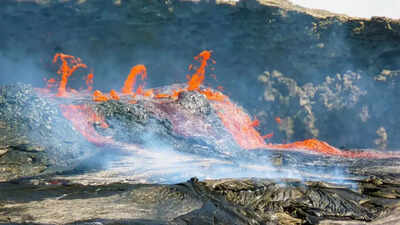In the Afar Depression of East Africa, a unique geological hotspot where three tectonic plates converge, scientists have uncovered compelling evidence of Earth's mantle playing a pivotal role in the continent's ongoing division. New research indicates that upwellings from the mantle beneath the region are not uniform but rather occur in complex, pulsating waves of molten material. This dynamic geological activity is not only triggering volcanic eruptions and earthquakes but also actively weakening the Earth’s crust. The long-term consequence of this process is predicted to be the formation of a new ocean, geographically separating the Horn of Africa from the rest of the continent on a grand scale.

Image: Dr Derek Keir, University of Southampton/ University of Florence
Researchers from the University of Southampton and Swansea University conducted an analysis of lava samples collected from over 130 young volcanoes across the Afar region. Their findings revealed that the mantle beneath East Africa exhibits a rhythmic behavior, with pulses of partially molten rock surging towards the surface. Each pulse possesses a distinct chemical fingerprint, indicating that the mantle is not a homogenous entity but rather a mosaic of diverse materials. This dynamic activity is heavily influenced by the thickness and movement of the overlying tectonic plates.
In areas with rapid movement, such as the Red Sea Rift, the mantle flow is more concentrated and intense. Conversely, in regions with slower rifting, it spreads more gradually. These pulses traverse weakened areas of the Earth's crust, rendering them more susceptible to volcanic eruptions. The chemical variations observed in the lava mirror cardiovascular rhythms and reflect the deep Earth’s internal tempo. This offers valuable insight into the correlation between volcanic activity on the surface and the hidden processes occurring far beneath our feet.
The plume's activity is also causing the lithosphere, Earth's outermost shell, to erode, reducing its thickness to a mere 15 kilometers in certain areas of the Afar Depression. As the plates continue to stretch and thin, they create pathways for even more lava to reach the surface, resulting in recurrent cycles of volcanic eruptions and seismic events. This process is reminiscent of the events that shaped the Atlantic Ocean millions of years ago.
The geological activity in the Afar region is part of a broader phenomenon known as continental rifting. In this area, the African, Arabian, and Somali tectonic plates are diverging. The resulting space is being filled with rising magma and newly formed crust. As rifting progresses, it is anticipated that seawater will eventually flow in and permanently inundate the region, giving rise to a new ocean basin, similar to the Atlantic Ocean that once separated Europe and North America.
The ongoing volcanic activity is already transforming the landscape. Lava flows from the Erta Ale volcano cover extensive areas of Ethiopia, and frequent earthquake swarms mark zones of intense tectonic stress. The Boset Volcano showcases numerous layers of volcanic deposits, illustrating the long-term accumulation of geological events driven by the mantle’s upwelling.
These discoveries provide not only a real-time glimpse into the birth of an ocean but also offer insights into understanding Earth's climate and history. Similar mantle plumes in the past have generated massive volcanic provinces like the North Atlantic Igneous Province, which contributed to significant climate changes and potentially even mass extinctions through the release of CO₂ and sulfur dioxide.
Scientists emphasize the importance of collaborative efforts across institutions and disciplines to fully comprehend these complex dynamics. Future research will focus on mapping mantle flows beneath other thinning tectonic plates and predicting how these deep forces influence surface geology. Ultimately, the Afar region serves as a natural laboratory for observing the interplay between Earth's interior and its evolving surface in action.
Newer articles
 Smith Targets Test Return After Baseball Cage Recovery Stint
Smith Targets Test Return After Baseball Cage Recovery Stint
 Rishabh Pant's Fearless Batting Revolutionizing Test Cricket, Says Greg Chappell
Rishabh Pant's Fearless Batting Revolutionizing Test Cricket, Says Greg Chappell
 Gavaskar Calls for Kuldeep Yadav's Inclusion Amid Bumrah Fitness Concerns Ahead of Second England Test
Gavaskar Calls for Kuldeep Yadav's Inclusion Amid Bumrah Fitness Concerns Ahead of Second England Test
 Oral Cancer: Spotting the Signs, Understanding the Risks, and Why Early Detection is Key to Survival
Oral Cancer: Spotting the Signs, Understanding the Risks, and Why Early Detection is Key to Survival
 5 Silent Signals of Prediabetes You Shouldn't Ignore
5 Silent Signals of Prediabetes You Shouldn't Ignore
 Vitamin D Could Slash Tooth Decay Risk by 50%, New Study Finds
Vitamin D Could Slash Tooth Decay Risk by 50%, New Study Finds
 Silent Signals: Don't Ignore These 5 Early Warning Signs of Liver Disease
Silent Signals: Don't Ignore These 5 Early Warning Signs of Liver Disease
 Brain's "15-Second Rule" Explains Why You're Always Seeing the Past, Study Reveals
Brain's "15-Second Rule" Explains Why You're Always Seeing the Past, Study Reveals
 Akmal Slams PCB's Interim Coach Pick: Questions Logic Behind Mahmood Appointment
Akmal Slams PCB's Interim Coach Pick: Questions Logic Behind Mahmood Appointment
 Nitish Rana Eyes Delhi Return After Disappointing Uttar Pradesh Stint
Nitish Rana Eyes Delhi Return After Disappointing Uttar Pradesh Stint